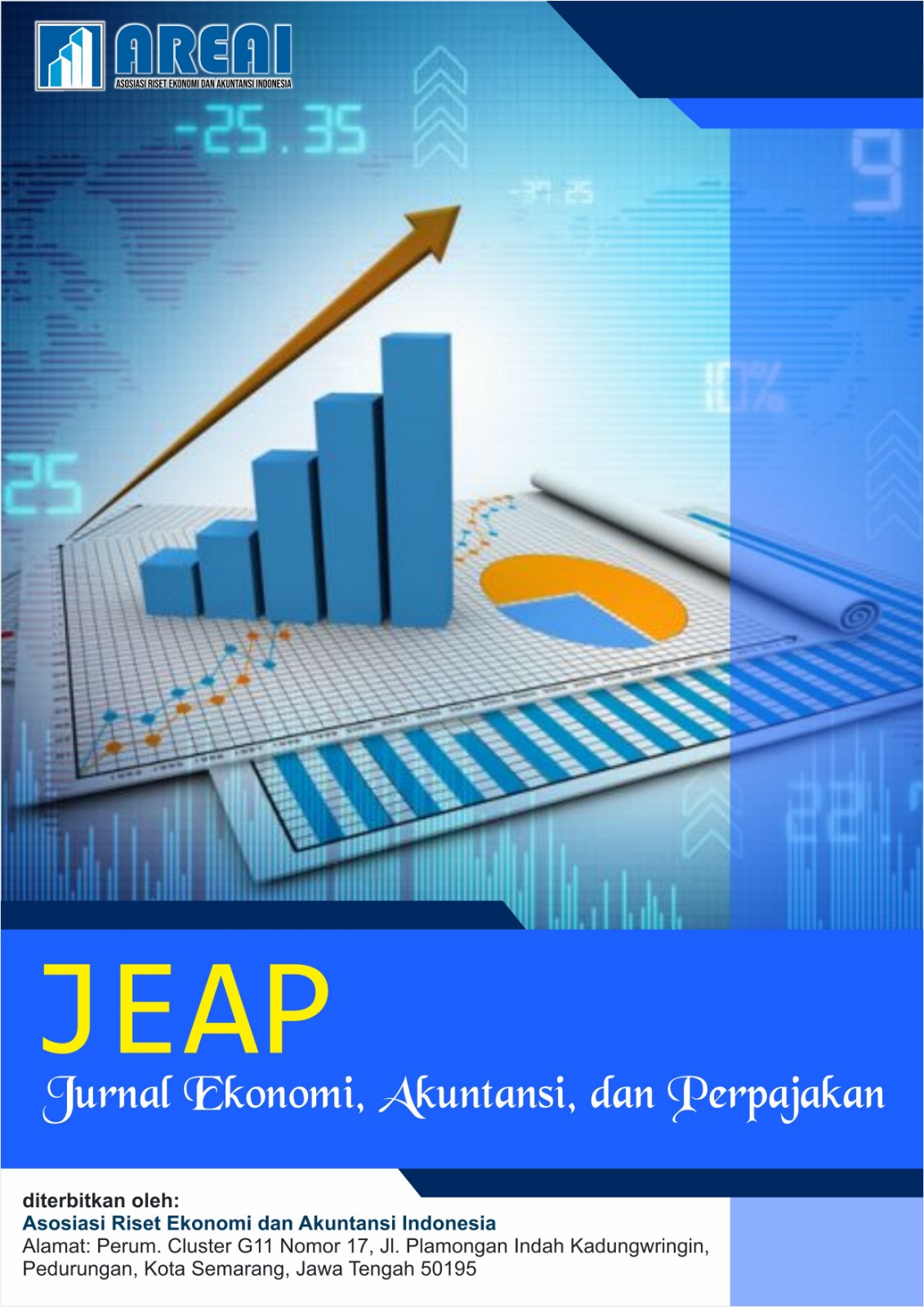Dampak Implementasi PSAK No 69 terhadap Kinerja Pasar melalui Kinerja Perusahaan Sebagai Variabel Pemediasi Pada Perusahaan Sektor Agrikultur di Indonesia
DOI:
https://doi.org/10.61132/jeap.v2i2.893Keywords:
Agricultural Sector, PSAK No. 69, Return on Equity, Stock ReturnAbstract
This study aims to analyze and evaluate the impact of the implementation of PSAK No. 69 (Biological Assets) on market performance, with company performance acting as a mediating variable, in agricultural sector companies listed in Indonesia. PSAK No. 69 was adopted to improve transparency and reliability in the financial reporting of biological assets, which are a significant component in the agricultural industry. The research adopts a quantitative approach, utilizing secondary data derived from the annual financial reports of companies and stock price information accessed via the Indonesia Stock Exchange (IDX) and the official websites of relevant companies for the period of 2018–2023.The study investigates the relationship between the intensity of biological assets and company performance, as measured by Return on Equity (ROE), as well as the relationship between company performance and market performance, as measured by Stock Return. The analysis results indicate that the intensity of biological assets has a significant positive impact on ROE. However, the direct effect of biological asset intensity on Stock Return is not statistically significant. Nevertheless, the mediation test reveals that ROE has a significant positive effect on Stock Return, thereby confirming the mediating role of ROE in the relationship between biological asset intensity and Stock Return.These findings imply that the implementation of PSAK No. 69 indirectly affects market performance through its influence on company performance. This highlights the importance of financial performance as a transmission channel in understanding the market implications of accounting regulation changes. The study provides useful insights for investors, regulators, and other stakeholders in evaluating the financial and market consequences of biological asset accounting standards in the agricultural sector.
Downloads
References
Abqari, L. S., & Hartono, U. (2020). Pengaruh rasio-rasio keuangan terhadap harga saham sektor agrikultur di Bursa Efek Indonesia periode 2014–2018. Jurnal Ilmu Manajemen, 8(4), 1372–1382. https://doi.org/10.26740/jim.v8n4.p1372-1382
Aminah, A., Suhardjanto, D., Rahmawati, R., Winarna, J., & Oktaviana, D. (2022). Biological asset disclosure in Indonesia. Ilomata International Journal of Tax and Accounting, 3(4), 397–407. https://doi.org/10.52728/ijtc.v3i4.561
Carolina, A., Kusumawati, F., & Chamalinda, K. N. L. (2020). Firm characteristics and biological asset disclosure on agricultural firms. Jurnal Akuntansi dan Keuangan, 22(2), 59–71. https://doi.org/10.9744/jak.22.2.59-71
Coleman, B. D., & Fuoss, R. M. (1955). Quaternization kinetics. I. Some pyridine derivatives in tetramethylene sulfone. Journal of the American Chemical Society, 77(21), 5472–5476. https://doi.org/10.1021/ja01626a006
Ghozali, I. (2018). Aplikasi analisis multivariate dengan program IBM SPSS 25 (Edisi ke-9). Badan Penerbit Universitas Diponegoro.
Gonçalves, R., & Lopes, P. (2014). Firm-specific determinants of agricultural financial reporting. Procedia - Social and Behavioral Sciences, 110, 470–481. https://doi.org/10.1016/j.sbspro.2013.12.891
Gonçalves, R., Lopes, P., & Craig, R. (2017). Value relevance of biological assets under IFRS. Journal of International Accounting, Auditing and Taxation, 29, 118–126. https://doi.org/10.1016/j.intaccaudtax.2017.10.001
Gumanti, T. A. (2012). Teori sinyal dalam manajemen keuangan. Manajemen Usahawan Indonesia, 38(Desember), 0–29.
Ika, S. R., Farida, F. N., Asih, S. N., Okfitasari, A., & Widagdo, A. K. (2024). The impact of biological asset disclosures and economic sustainability on firm value: Evidence from agricultural companies in Indonesia. IOP Conference Series: Earth and Environmental Science, 1297(1), 012069. https://doi.org/10.1088/1755-1315/1297/1/012069
Ikatan Akuntan Indonesia. (2020). Pernyataan Standar Akuntansi Keuangan (PSAK) No. 69: Agrikultur. Dewan Standar Akuntansi Keuangan.
Kadri, M. H., Mohd Amin, J., & Abu Bakar, Z. (2023). Examining the value relevance of biological assets and their fair value change in Malaysia. International Journal of Academic Research in Accounting, Finance and Management Sciences, 13(1). https://doi.org/10.6007/ijarafms/v13-i1/16574
Ketut Tantra Riana, S. K. S. D. (2021). Peran EPS dalam memediasi pengaruh ROE terhadap harga saham perusahaan perbankan di BEI. Tjyybjb.ac.cn, 27(2), 635–637.
Kohar, A., Widyastuti, T., & Ahmar, N. (2024). Biological asset intensity and profitability as determinants of firm value: Exploring the mediating effect of disclosure practices. Journal name missing, 22, 17524–17535.
Kurniawan, R., & Mulawarman, A. D. (2014). Biological assets valuation reconstruction: A critical study of IAS 41 on agricultural accounting in Indonesian farmers. Procedia - Social and Behavioral Sciences, 164, 68–75. https://doi.org/10.1016/j.sbspro.2014.11.052
Nguyen, N. (2018). Hidden Markov model for stock trading. International Journal of Financial Studies, 6(2). https://doi.org/10.3390/ijfs6020036
PwC. (2019). A practical guide to the new and revised Indonesian Financial Accounting Standards for 2019.
Shepel, T., & Narkiewicz, J. (2018). Economic and methodical basis of biological assets measurement under conditions of accounting transformation towards IFRS. Economics, Entrepreneurship, Management, 5(2), 19–26. https://doi.org/10.23939/eem2018.02.019
Utami, E. R., & Prabaswara, A. (2020). The role of biological asset disclosure and biological asset intensity in influencing firm performance. Journal of Accounting and Investment, 21(3). https://doi.org/10.18196/jai.2103163
Downloads
Published
How to Cite
Issue
Section
License
Copyright (c) 2025 Jurnal Ekonomi, Akuntansi, dan Perpajakan

This work is licensed under a Creative Commons Attribution-ShareAlike 4.0 International License.





